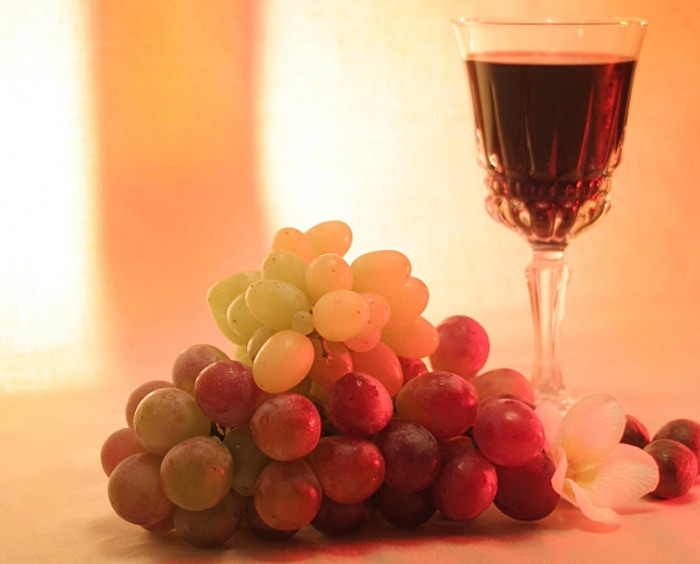It doesn’t matter whether you’re working with a kit, juice or fruit the basic components of winemaking are the same. If you’re a novice, I suggest starting by making a kit wine. after you’ve made a couple of small five-gallon (19-L) batches under your belt then you can move to fresh juice or fruit.
One Gallon Glass Carboy
1. Grapes

Making wine is fairly easy. No stainless steel vats, or advanced measurement and testing equipment are necessary; our Sumerian predecessors were able to do it with basic tools such as the stone bowl, wooden barrels and even a little luck.
It is essential to choose good grapes. Cut off the stems of the fruit, and crush it so that you can extract the juice. The crushed grapes can then be left on the skins for red wine, or press them off, leaving only the juice to make white wine.
You can use a fermentation bucket or a standard clear glass container with a tightly sealed cap to ferment your wine. One benefit of using a bucket is that it provides an easier, safer and more reliable way to verify that your wine is in the process of fermenting.
There is about 1kg grapes for a litre of wine. About 40 clusters of grapes will be required to make 10 bottles (or greater depending on the grape variety). You can measure the sugar level in your grape juice using the hydrometer. Add sugar to reach a starting density of 1080-1085g/l with an approximate 11-12 percentage alcohol.
2. Wine Yeast
The primary ingredient in making wines is the yeast. It’s the thing that converts sugar into alcohol, giving wine its distinct character. It is what makes wine distinct from grape juice. ufabet allows it to produce flavours that weren’t there in the grapes.
As the fermentation progresses, yeast releases aromatic compounds referred as esters. They enrich the wine with fruity aromas and phenolics, which give wine structure and body. It also makes acetaldehyde an aldehyde usually associated with wine spoilage, however it adds to the wine’s richness by increasing the aroma.
When choosing a type of yeast winemakers take into account its attenuation and the amount of sugar the yeast will be in a position to ferment. High attenuation rates can allow for a less alcoholic final percentage of the wine.
The winemaker must also provide ample clean, fresh drinking water in order for yeast to thrive. The water needs to be cleansed to eliminate any additives that may contaminate the wine. It is also important to ensure that the vessel used for fermentation is adequately ventilated throughout the process, especially if it is not in an air-tight container. Proper ventilation will prevent excessive temperatures from slowing or stopping the process of fermentation.
3. Water
The components used to create wine are diverse. Additionally, it’s possible to create wine in various styles. Most wine is made from grapes. Numerous homebrewers try other fruits in order to produce wine with their own unique style and taste.
The water utilized in the production of wine is another vital ingredient that you should consider. It is perfectly safe to use tap water from your municipal supply to be used for wine. But you need to add a teaspoon of Yeast Nutrient for every gallon added water. It’s a rich nitrogen source that will encourage fermentation.
Avoid using the distilled wine that you make since it’s had all important nutrients removed from it. It will negatively affect the end product.
Keep in mind the fact that the level of alcohol will vary based upon the sugars used. It is easy to determine the level of alcohol present in your wine using a hydrometer. At the end of the day, a simple wine with a grape flavor contains about 7% of alcohol.
4. Sugar
The majority of alcohol-based drinks start with sugar, and then a chemical reaction changes it to alcohol. Grapes contain sugars in the form glucose and fructose. The wines made from other fruits such as grapes or fruit are often sweetened to counteract the acidity.
The majority of wine recipes are adaptable enough to accommodate the addition of sugar in order to produce different taste profiles. Most winemakers use white sugar. However, the brown sugar and molasses as well as honey are all options for the exact taste that you prefer.
Sugar is absorbed by yeast right at the beginning of fermentation, and is transformed into carbon dioxide and alcohol. The quantity of sugar used will depend on the temperature and recipe as well as the preferences of wine-drinkers.
If adding sugar into wine in the process of fermentation, it is important to dissolve it in boiling water prior to adding it. If not, the sugar will precipitate out and be left as particles in the wine bottle. It can affect the tasting of the wine. It may result in a unappetizing or cloudy wine.
5. Honey
Sugar is essential for the process of making alcohol. The process of fermentation is carried out by using grapes and other fruits. Beer makes use of malted grains. The mead (or honey wine) is different because it gets its sugar from a completely naturally-sourced source: honey.
It is possible to flavor the ferment by adding different spice and herbs, however it’s often best left unflavored to allow honey’s distinctive flavour to come through. Mead is generally thought to be a distinct category within the alcohol industry and is among the oldest known drink that is alcoholic.
In order to make a basic one-gallon mead, dissolve 1 one pound. in boiling water and then let it cool. The large fermentation glass the jug. Make a honey-water mixture. Dissolve yeast in 14 cup of hot water. Add to honey water mix. Pour the honey and water mixture into the large fermenting glass jug and seal it by using a rubber stopper or waterlock and keep somewhere at a temperature that is warm.
It is possible to use honey in almost any recipe for wine by making a substitute for some or all the sugar required in the recipe with honey. Use only quality honey. It has to be local and organic, so that you avoid sulfites which could hinder fermentation.
